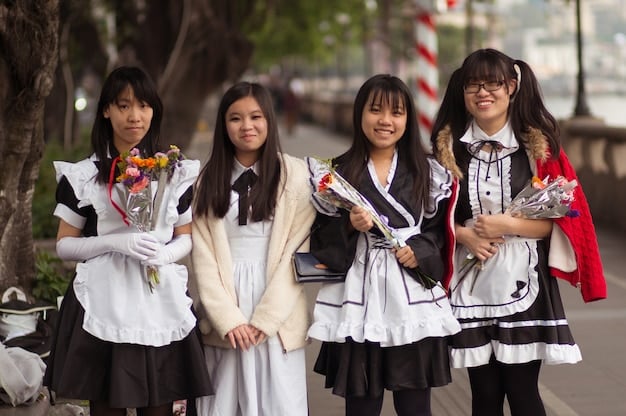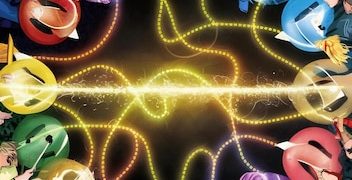The Enduring Appeal of High School J-Dramas: Why We Love Them

High school J-dramas maintain a dedicated following due to their relatable themes, charming characters, and unique cultural insights into Japanese adolescence, offering viewers a blend of lighthearted entertainment and nostalgic appeal.
The world of Japanese dramas, or J-dramas, offers a diverse range of genres, but few are as consistently popular as those set in high schools. The enduring appeal of high school J-dramas lies in their ability to transport us back to our youth, explore universal themes of friendship and self-discovery, and provide a glimpse into Japanese culture.
Why High School J-Dramas Resonate with Audiences
High school J-dramas resonate deeply with audiences for a multitude of compelling reasons. These dramas aren’t simply about teenage romance; they delve into universal experiences, exploring themes that resonate across cultures and generations.
Relatable Themes
One of the primary reasons for their popularity is the exploration of relatable themes. These dramas often focus on issues such as:
- Friendship: The bonds between friends are often a central focus, depicting the challenges and joys of navigating social circles and supporting one another through personal struggles.
- First Love: The awkwardness, excitement, and heartbreak of first love are common themes, evoking a sense of nostalgia and empathy in viewers.
- Self-Discovery: High school is a time of significant personal growth, and these dramas often portray characters grappling with their identities, values, and aspirations.
- Academic Pressure: The immense pressure to succeed academically, a significant aspect of Japanese culture, is often explored, highlighting the stress and anxieties faced by students.
By addressing these universal themes, high school J-dramas transcend cultural boundaries, creating a connection with audiences regardless of their background.
Nostalgic Appeal
For many viewers, these dramas evoke a strong sense of nostalgia. They transport us back to a time of youthful innocence, first experiences, and the bittersweet transition from adolescence to adulthood.

The familiar settings, such as classrooms, school festivals, and after-school clubs, trigger memories and emotions associated with our own high school experiences. The vibrant colors, catchy soundtracks, and charming characters further enhance this nostalgic feeling.
In conclusion, the blend of relatable themes and nostalgic appeal makes high school J-dramas a comforting and engaging form of entertainment for a wide audience.
The Charm of Japanese Culture in High School Dramas
Beyond the universal themes, high school J-dramas offer a unique window into Japanese culture. They provide insights into the values, traditions, and social dynamics that shape the lives of Japanese teenagers.
School Life in Japan
These dramas offer a glimpse into the daily lives of Japanese high school students. They depict the rigorous academic schedules, the importance of extracurricular activities, and the unique dynamics between students and teachers.
Viewers can learn about aspects of Japanese school life, such as:
- Uniforms: The iconic Japanese school uniforms are a visual symbol of conformity and belonging.
- Club Activities: Clubs play a vital role in Japanese high schools, providing opportunities for students to pursue their interests and develop their skills.
- School Events: Events such as school festivals, sports days, and cultural performances showcase the vibrant and communal atmosphere of Japanese schools.
By showcasing these aspects of school life, high school J-dramas provide a cultural education that goes beyond textbooks and documentaries.
Social Dynamics and Values
The dramas also explore the social dynamics and values that are prevalent in Japanese society. They often portray the importance of harmony, respect for elders, and the pressure to conform to social expectations.
These dynamics are often reflected in the characters’ interactions and relationships. Viewers can observe how Japanese teenagers navigate social situations, resolve conflicts, and balance their individual desires with the needs of the group.
In summary, high school J-dramas offer a culturally rich experience, providing viewers with a deeper understanding of Japanese society and its values.
The Magic of Character-Driven Storytelling
The heart of any good drama lies in its characters, and high school J-dramas excel at creating memorable and relatable characters that viewers can connect with on an emotional level. The success often relies on character development and storylines.

The dramas often feature a diverse cast of characters, each with their own unique personalities, backgrounds, and struggles. These characters may include:
- The Protagonist: A relatable and often flawed character who undergoes significant personal growth throughout the series.
- The Best Friend: A loyal and supportive friend who provides guidance and encouragement.
- The Love Interest: A charming and often enigmatic character who captures the protagonist’s heart.
- The Rival: A competitive and often antagonistic character who challenges the protagonist and pushes them to improve.
Character Development
Throughout the series, the characters face challenges, overcome obstacles, and learn valuable lessons. Their journeys are often filled with moments of joy, sorrow, and self-discovery, allowing viewers to witness their growth and evolution.
The characters’ struggles with identity, acceptance, and belonging resonate with viewers who may be facing similar challenges in their own lives. The dramas often offer messages of hope and resilience, encouraging viewers to embrace their individuality and pursue their dreams.
Character-driven storytelling is a key element in the appeal of high school J-dramas. The relatable and well-developed characters create a strong emotional connection with viewers, making the dramas a truly immersive and engaging experience.
Music and Aesthetics: Enhancing the Emotional Impact
The visual and auditory elements of high school J-dramas play a crucial role in enhancing the emotional impact of the stories and creating a captivating viewing experience. Music and aesthetics serve to amplify storytelling.
The Power of Soundtracks
The soundtracks of these dramas are often carefully curated to complement the on-screen action and evoke specific emotions. The music can range from upbeat and energetic pop songs to melancholic ballads, reflecting the changing moods and themes of the series.
Opening and ending theme songs are particularly important, as they often encapsulate the overall tone and message of the drama. These songs can become iconic and associated with the series long after it has ended, further enhancing its nostalgic appeal.
Visual Storytelling
The visual aesthetics of high school J-dramas are often bright, colorful, and visually appealing. The cinematography, costume design, and set design all contribute to creating a distinct and immersive world.
The use of symbolism and visual metaphors can also enhance the storytelling, adding layers of meaning and depth to the narrative. For example, the changing seasons can be used to represent the characters’ emotional journeys and the passage of time.
In essence, the music and aesthetics of high school J-dramas work together to create a sensory experience that amplifies the emotional impact of the stories and captivates viewers’ imaginations.
Comparing High School J-Dramas to Western Teen Dramas
While high school dramas are a popular genre in both Japan and the West, there are some key differences in their approaches and thematic focuses. Understanding these distinctions can shed light on the unique appeal of J-dramas.
Cultural Nuances
One of the most significant differences lies in the cultural nuances. J-dramas often emphasize themes of community, tradition, and respect for authority, reflecting the values of Japanese society.
Western teen dramas, on the other hand, often focus on individualism, rebellion, and the exploration of personal freedom. They may also tackle more controversial topics, such as drug use, sexuality, and violence, which are less commonly addressed in J-dramas.
Stylistic Differences
There are also stylistic differences in the way these dramas are presented. J-dramas tend to be more melodramatic and emotionally expressive, with characters often displaying exaggerated reactions and over-the-top performances.
Western teen dramas, while still emotional, often adopt a more realistic and understated approach, with characters expressing their feelings in a more subtle and nuanced manner.
Different Focuses
Despite these differences, both types of dramas share some common themes, such as friendship, love, and self-discovery. However, they may explore these themes in different ways, reflecting the cultural values and social norms of their respective societies.
Ultimately, the choice between watching a high school J-drama and a Western teen drama comes down to personal preference. Some viewers may prefer the culturally rich and emotionally expressive style of J-dramas, while others may prefer the more realistic and nuanced approach of Western dramas.
Where to Find and Watch High School J-Dramas
With the increasing popularity of J-dramas, there are now more platforms than ever offering a wide selection of these shows. Knowing where to look can help you discover your next favorite series.
Streaming Services
Several popular streaming services offer a variety of J-dramas, including high school dramas. These services often provide subtitles in multiple languages, making it easier for viewers around the world to enjoy the shows. Some examples include:
- Netflix: Offers a growing selection of J-dramas, including both classic and contemporary series.
- Crunchyroll: Primarily known for anime, but also features a selection of J-dramas.
- Viki: Specializes in Asian dramas, including a wide variety of J-dramas with fan-submitted subtitles.
Online Communities
In addition to streaming services, there are also numerous online communities and forums dedicated to J-dramas. These communities can be a valuable resource for finding recommendations, discussing favorite shows, and connecting with other fans.
Websites such as:
- MyDramaList: A comprehensive database of Asian dramas, including J-dramas, with ratings, reviews, and cast information.
- Reddit: Various subreddits dedicated to J-dramas where fans share news, recommendations, and discussions.
These platforms provide a wealth of information and resources for both newcomers and experienced J-drama viewers.
The Future of High School J-Dramas
The future of high school J-dramas looks bright, with the genre continuing to evolve and adapt to changing audience preferences and technological advancements. New technologies are also playing a role.
These dramas are consistently reinventing the genre by:
- Expanding to New Platforms: As streaming services continue to grow in popularity, J-dramas are reaching wider audiences than ever before. This increased accessibility is likely to fuel further growth and innovation in the genre.
- Experimenting with New Themes and Formats: High school J-dramas are likely to continue exploring a wider range of themes and topics, reflecting the evolving concerns and interests of young people. They may also experiment with new formats, such as shorter episodes, interactive narratives, and web series.
- Adapting to Global Audiences: As J-dramas gain popularity internationally, creators may increasingly tailor their stories to appeal to global audiences, incorporating universal themes and cultural references.
The future of high school J-dramas is sure to be filled with exciting new stories, characters, and experiences, continuing to captivate audiences for generations to come.
| Key Aspect | Brief Description |
|---|---|
| 🏫 Relatable Themes | Exploration of universal themes like friendship and first love. |
| 🌸 Cultural Insights | Glimpse into Japanese school life and social dynamics. |
| 🎵 Music & Aesthetics | Use of impactful soundtracks and visually appealing cinematography. |
| 🌟 Character-Driven Narratives | Stories propelled by relatable and well-developed characters. |
Frequently Asked Questions
▼
High school J-dramas are popular for their relatable themes, insights into Japanese culture, strong character development, and captivating visual and auditory elements. They offer a blend of entertainment and cultural understanding.
▼
High school J-dramas often emphasize tradition, community, and respect for authority, reflecting Japanese values. Western teen dramas tend to focus on individualism and rebellion, addressing more controversial topics.
▼
You can find high school J-dramas on streaming services like Netflix, Crunchyroll, and Viki. Online communities and forums, such as MyDramaList and Reddit, are also valuable resources for recommendations.
▼
Common themes include friendship, first love, self-discovery, and academic pressure. These dramas often explore the challenges and joys of navigating adolescence and finding one’s place in the world.
▼
Music plays a crucial role in enhancing the emotional impact of high school J-dramas. Soundtracks are carefully curated to complement the on-screen action and evoke specific emotions, adding depth to the narrative.
Conclusion
The enduring appeal of high school J-dramas lies in their ability to blend universal themes with unique cultural insights, creating a captivating and emotionally resonant viewing experience. From relatable characters to evocative music and aesthetics, these dramas offer something for everyone, continuing to captivate audiences worldwide.





